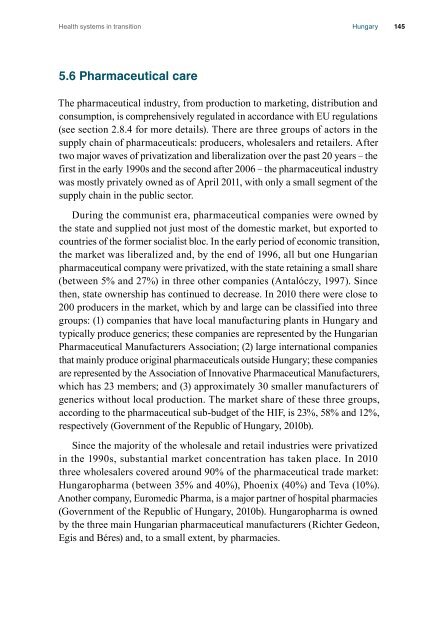Health Systems in Transition - Hungary - World Health Organization ...
Health Systems in Transition - Hungary - World Health Organization ...
Health Systems in Transition - Hungary - World Health Organization ...
You also want an ePaper? Increase the reach of your titles
YUMPU automatically turns print PDFs into web optimized ePapers that Google loves.
<strong>Health</strong> systems <strong>in</strong> transition <strong>Hungary</strong> 145<br />
5.6 Pharmaceutical care<br />
The pharmaceutical <strong>in</strong>dustry, from production to market<strong>in</strong>g, distribution and<br />
consumption, is comprehensively regulated <strong>in</strong> accordance with EU regulations<br />
(see section 2.8.4 for more details). There are three groups of actors <strong>in</strong> the<br />
supply cha<strong>in</strong> of pharmaceuticals: producers, wholesalers and retailers. After<br />
two major waves of privatization and liberalization over the past 20 years – the<br />
first <strong>in</strong> the early 1990s and the second after 2006 – the pharmaceutical <strong>in</strong>dustry<br />
was mostly privately owned as of April 2011, with only a small segment of the<br />
supply cha<strong>in</strong> <strong>in</strong> the public sector.<br />
Dur<strong>in</strong>g the communist era, pharmaceutical companies were owned by<br />
the state and supplied not just most of the domestic market, but exported to<br />
countries of the former socialist bloc. In the early period of economic transition,<br />
the market was liberalized and, by the end of 1996, all but one Hungarian<br />
pharmaceutical company were privatized, with the state reta<strong>in</strong><strong>in</strong>g a small share<br />
(between 5% and 27%) <strong>in</strong> three other companies (Antalóczy, 1997). S<strong>in</strong>ce<br />
then, state ownership has cont<strong>in</strong>ued to decrease. In 2010 there were close to<br />
200 producers <strong>in</strong> the market, which by and large can be classified <strong>in</strong>to three<br />
groups: (1) companies that have local manufactur<strong>in</strong>g plants <strong>in</strong> <strong>Hungary</strong> and<br />
typically produce generics; these companies are represented by the Hungarian<br />
Pharmaceutical Manufacturers Association; (2) large <strong>in</strong>ternational companies<br />
that ma<strong>in</strong>ly produce orig<strong>in</strong>al pharmaceuticals outside <strong>Hungary</strong>; these companies<br />
are represented by the Association of Innovative Pharmaceutical Manufacturers,<br />
which has 23 members; and (3) approximately 30 smaller manufacturers of<br />
generics without local production. The market share of these three groups,<br />
accord<strong>in</strong>g to the pharmaceutical sub-budget of the HIF, is 23%, 58% and 12%,<br />
respectively (Government of the Republic of <strong>Hungary</strong>, 2010b).<br />
S<strong>in</strong>ce the majority of the wholesale and retail <strong>in</strong>dustries were privatized<br />
<strong>in</strong> the 1990s, substantial market concentration has taken place. In 2010<br />
three wholesalers covered around 90% of the pharmaceutical trade market:<br />
Hungaropharma (between 35% and 40%), Phoenix (40%) and Teva (10%).<br />
Another company, Euromedic Pharma, is a major partner of hospital pharmacies<br />
(Government of the Republic of <strong>Hungary</strong>, 2010b). Hungaropharma is owned<br />
by the three ma<strong>in</strong> Hungarian pharmaceutical manufacturers (Richter Gedeon,<br />
Egis and Béres) and, to a small extent, by pharmacies.
















